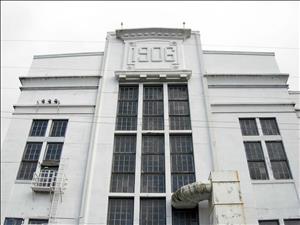On October 15, 1952, the long-idled Georgetown Steam Plant is fired up to produce electricity for public use for the final time. Built in 1906, put into operation in 1907, and bought by Seattle City Light in 1951, the old standby is called back to action when high demand and record-low water levels on the Columbia River strain the Bonneville Power Administration's ability to meet regional needs. Georgetown's three steam-turbine-powered generators will be run for 16 hours a day and will continue supplying power to the grid into the early months of 1953. After the crisis passes, the plant will be maintained in operating condition for years, but never again called upon to provide electricity.
Seldom Used, Always Ready
The Georgetown Steam Plant, located in South Seattle adjacent to the northwest corner of King County International Airport (Boeing Field), was built in 1906 by the Seattle Electric Company, an umbrella corporation for the various electrical-generation and public-transportation companies in the Seattle area controlled by Stone & Webster, a Boston-based utilities conglomerate. The plant was an early example of the use of steel-reinforced-concrete in industrial buildings and was equipped with two early-twentieth-century state-of-the-art vertical steam turbines that spun generators to produce alternating current. From the beginning, Georgetown's primary role was to supplement and back up the output of the company's existing and planned hydroelectric plants. A third, horizontal turbine and generator were added to provide extra electricity for manufacturing related to World War I, but was not operational until after the war ended.
In a remarkably short span of years, electricity had moved from being a parlor-trick curiosity to a necessity of urban life. Interruptions in supply could cause major inconveniences for private consumers and considerable financial loss to factories and businesses that were dependent on a reliable supply of relatively inexpensive power. Even when new, the Georgetown Steam Plant supplied only about 5 percent of Seattle Electric's total needs. By 1916 the company had four hydroelectric plants in operation, and Georgetown's contribution was reduced to about 1 percent of the total power produced.
Crisis
Record-low water levels on the Columbia River in the late summer of 1952 caused the Bonneville Power Administration to warn that it would have to reduce its electrical production from the hydroelectric dams on the river by 150,000 kilowatts, and that several large industrial customers could face brownouts. Seattle City Light, which had purchased the Georgetown Steam Plant from Puget Sound Power & Light (successor to the Seattle Electric Company) the previous year, produced sufficient electricity for its own needs, but was obligated to contribute to the Northwest Power Pool. The pool was established in 1942 to tie together many of the Northwest's separately owned generating and transmission systems into a kind of web, with electricity flowing back and forth as the needs of each member system required.
To fulfill its obligations to the pool, Seattle City Light started up the Lake Union Steam Plant in early September 1952, producing 40,000 kilowatts of electricity. But more was needed, and on September 16, Superintendent E. R. Hoffman announced that the Lake Union plant would increase its operations from 16 hours a day to 24, and that preparations were being made to restart the idled Georgetown facility, which had a capacity of 21,000 kilowatts. Both had long been out of regular operation, and the utility began placing want-ads in Seattle newspapers to find steam engineers to run the equipment.
One Last Time
On October 15, 1952, the Georgetown Steam Plant was started up and put into operation, feeding electricity into the intercompany pool for 16 hours each day. It continued in use until the early months of 1953 before again being taken out of service. Record electricity consumption in Seattle in December 1964 briefly spurred plans to start the old plant once again, but the crisis passed before this became necessary. Both the Georgetown and Lake Union steam plants were tested yearly, demonstrating a preparedness that entitled Seattle City Light to a $1 million annual credit from the Bonneville Power Administration for maintaining "available capability" ("Steam Plants, Unused ... ").
The last serious consideration of putting the Georgetown plant back into operation came in September 1973, when reservoir levels for hydropower became critically low. But a variety of obstacles intervened. The Puget Sound Air Pollution Control Agency initially indicated that City Light would need an air-quality variance to operated Georgetown's aged oil-fueled boilers, before determining, based on the Lake Union plant's operation, that Georgetown would not violate air-pollution standards. There were other problems though, including a lack of trained steam engineers to operate the equipment and concerns about discharging the plant's heated waste-water into the Duwamish River. Then, in October 1973, the OPEC (Organization of Petroleum Exporting Countries) oil embargo began, and City Light was unable to obtain oil to operate the Georgetown plant during the hydropower shortage.
On January 24, 1977, Seattle City Light Superintendant Gordon Vickery (1920-1996) informed the city council that the agency was planning to "abandon" the 70-year-old Georgetown Steam Plant the following June ("City Light to Close Antique ... "). Before the year was out, preservationists had nominated the facility for inclusion on the National Register of Historic Places. In 1980 the plant was designated a National Historical Mechanical Engineering Landmark by the American Society of Mechanical Engineers and it became a National Historic Landmark and a Seattle Historic Landmark in 1984. As of 2016 the plant remained where it was built more than a century earlier, its vintage generating equipment still in place, although no longer maintained.

